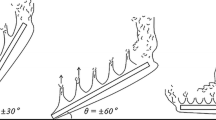Abstract
An electrochemical technique is used to study local mass transfer coefficients on surfaces of inclined enclosures over the range 1.1×104 < RaH < 1.4×1010 for a nominal Schmidt number of 2280. Scaling with gcosθ instead of g in the Rayleigh number correlates the data well at low angles of inclination; however, as either the aspect ratio or the angle of inclination increase, the longitudinal density stratification causes the data to deviate from a power law scaling.








Similar content being viewed by others
Notes
We assume that for the fluid of interest, density decreases with temperature
Abbreviations
- ΔCi::
-
Concentration difference for species i(mol/l)
- Di::
-
Diffusion coefficient of species i (m2/s)
- F::
-
Faraday’s constant (96,487 C/g mol)
- g::
-
Acceleration due to gravity (9.8 m/s2)
- h::
-
Mass transfer coefficient
- H::
-
Thickness of fluid layer between electrodes (m)
- i::
-
Species of interest (copper ions)
- I::
-
Current (A)
- L::
-
Length of cathode surface (m)
- ni::
-
Valence of transferred ion
- Pr::
-
Prandtl number (ν/α)
- RaL::
-
Mass transfer Rayleigh number based on cathode length [g(ρbulk-ρc) L3/ρν Di]
- RaH::
-
Mass transfer Rayleigh number based on enclosure height [g(ρbulk-ρc)H3/ρν Di]
- Rax::
-
Local mass transfer Rayleigh number [g(ρbulk-ρc) x3/ρν Di]
- Sc::
-
Schmidt number (ν/Di)
- Sh::
-
Sherwood number (hL/Di)
- Shx::
-
Local Sherwood number (hx/Di)
- ti::
-
Transference number
- W::
-
Width of cathode plate (m)
- x::
-
Position from leading edge of cathode surface (m)
- δ::
-
Boundary layer thickness (m)
- λr::
-
Width between adjacent rolls (m)
- ν::
-
Kinematic viscosity (m2/s)
- θ::
-
Angle of enclosure inclination from horizontal (degrees)
- θ*::
-
Transition angle from longitudinal rolls to unicellular flow (degrees)
- ρ::
-
Density (kg/m3)
References
Arnold JN, Catton I, Edwards DK (1976) Experimental investigation of natural convection in inclined rectangular regions of differing aspect ratios. J Heat Trans 98:67–71
Ayyaswamy PS, Catton I (1973) The boundary layer regime for natural convection in a differentially heated, tilted rectangular cavity. J Heat Trans 95:543–545
Buchberg H, Catton I, Edwards DK (1976) Natural convection in enclosed spaces—a review of application to solar energy collectors. J Heat Trans 98:182–188
Catton I (1978) Natural convection in enclosures. In: International Heat Transfer Conference, Toronto, vol 6, pp 13–31
Chiang HD, Goldstein RJ, Khan V (1994) Natural convection turbulent mass transfer along an inclined surface. In: Proceedings of the 10th international heat transfer conference, vol 2, pp 213–218
Eckert ERG (1963) Introduction to heat and mass transfer. McGraw-Hill, New York, pp 187–189
ElSherbiny SM (1996) Free convection in inclined air layers heated from above. Int J Heat Mass Trans 29:3925–3930
Goldstein RJ, Chiang HD (1992) Application of the electrochemical mass transfer technique to the study of buoyancy-driven flows. In: Reizes JA (ed) Transport phenomena in heat and mass transfer. Elsevier Science Publishers, New York, pp 1–25
Goldstein RJ, Chiang HD, Sayer E (1988) Natural convection mass transfer in an inclined enclosure at high Rayleigh number. In: Hirata M, Kasagi N (eds) Transport phenomena in turbulent flows. Hemisphere Publishing Corporation, New York, pp 459–485
Hamady FJ, Lloyd JR, Yang HQ, Yang KT (1989) Study of natural convection heat transfer in an inclined enclosure. Int J Heat Mass Trans 32:1697–1708
Hart JE (1971) Stability of the flow in a differentially heated inclined box. J Fluid Mech 47:547–576
Hollands KGT, Unny TE, Raithby GD, Konicek L (1976) Free convection heat transfer across inclined air layers. J Heat Trans 98:189–193
Leong WH, Hollands KGT, Brunger AP (1999) Experimental Nusselt numbers for a cubical-cavity benchmark problem in natural convection. Int J Heat Mass Trans 42:1979–1989
Shadid JN, Goldstein RJ (1990) Visualization of longitudinal convection roll instabilities in an inclined enclosure heated from below. J Fluid Mech 215:196–212
Author information
Authors and Affiliations
Corresponding author
Rights and permissions
About this article
Cite this article
Goldstein, R.J., Chiang, H.D., Srinivasan, V. et al. Local mass transfer measurements in an inclined enclosure at high Rayleigh number. Heat Mass Transfer 41, 991–998 (2005). https://doi.org/10.1007/s00231-005-0630-0
Received:
Accepted:
Published:
Issue Date:
DOI: https://doi.org/10.1007/s00231-005-0630-0




